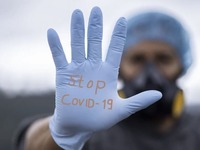The COVID-19 pandemic has demonstrated in a number of countries that access to RWD can be expedited or even new platforms developed, when there is both an urgent need and public health interest. Recent publications of interest include first the use of the TriNetX Analytics Network (which covers eight countries, 62 healthcare organizations and 81 million patients and is continuously growing) to investigate the 6-month neurological and psychiatric outcomes of COVID-19 survivors. The study demonstrated considerable morbidity with regards to these outcomes in a retrospective analysis of more than 200,000 patients and the critical need for appropriate follow-up care for these individuals [1]. The size of the dataset allowed rare events (e.g., Parkinsonism incidence of 0.1%) to be detected, which is important when trying to truly understand the burden of disease. Second, a multinational network cohort study across the USA, Spain, China and South Korea investigated treatments used during hospital admissions for COVID-19 [2]. Hard-to-obtain Spanish data were provided from two hospitals, available specifically as part of a COVID data sharing scheme, with the data overall showing tremendous heterogeneity in drug use during the early stages of the pandemic, as healthcare practitioners sought to understand which treatments worked against the disease. Third, OpenSAFELY, a UK analytics platform created to address urgent questions regarding the epidemiology of COVID-19 and encompassing 24 million individuals registered at GP practices using specific software [3], was used to investigate ethnic differences in COVID-19 hospitalizations and deaths. Considerable disparities by ethnicity for COVID-19 adverse outcomes were demonstrated, even after accounting for important covariates such as sociodemographic and household characteristics [4]. The OpenSAFELY dataset is perhaps up to six-times larger than more readily available UK GP datasets, allowing better National representation and statistical power for these types of analyses. Even larger still is the newly established CVD-COVID-UK dataset, accessed via the NHS Digital Trusted Research Environment, which provides person level hospital and GP data on 54 million patients in England (very nearly the entire country) [5]. The dataset has been created to understand the relationship between COVID-19 and cardiovascular outcomes; however, the team recognize the value of using this powerful resource for wider research. Finally in the Nordics, countries unprecedented for the Nationwide coverage and richness of data, but notoriously lengthy in terms of timelines to execute studies. As a result of approvals needed, rapid access to Danish and Norwegian healthcare registries was made possible. In this instance, the data were used to assess the risk of adverse events after administration of the Oxford–AstraZeneca vaccine and the researchers found that while there was a slight increase in relative risk for venous thromboembolic events, the absolute risk remained minimal [6]. While more data are now available as a result of the COVID-19 public health emergency, access remains exclusive to those researching COVID-19 and associated health outcomes. The pandemic has demonstrated unequivocally the importance of health to economies and society as a whole. We contend that the approval and continued assessments of new medicines should be viewed with the same lens. We recognize that while the acceleration of these data initiatives has required significant investment and prioritization of resources that may not be sustainable in the long term, we nevertheless believe it is vital that key stakeholders maintain the momentum that has been generated. We hope that access to these data sources can be opened up to all researchers with a genuine interest in health improvement and that timelines for accessing data can be similarly maintained in the future. Indeed as a relevant example, the International Headache Society recently called out the importance of RWD for HTA. In their position statement, they stated that RWD should be systematically considered when assessing the value of migraine treatments [7]. Failure to uphold the change in practice as a result of COVID-19 would undoubtedly represent a missed opportunity that has tremendous potential benefit for us all. Source: Alex Simpson & Sreeram V Ramagopalan. R WE ready for reimbursement? A round up of developments in RWE relating to health technology assessment: part 2. Published Online:29 Jun 2021. https://doi.org/10.2217/cer-2021-0144 References:
|
||





























